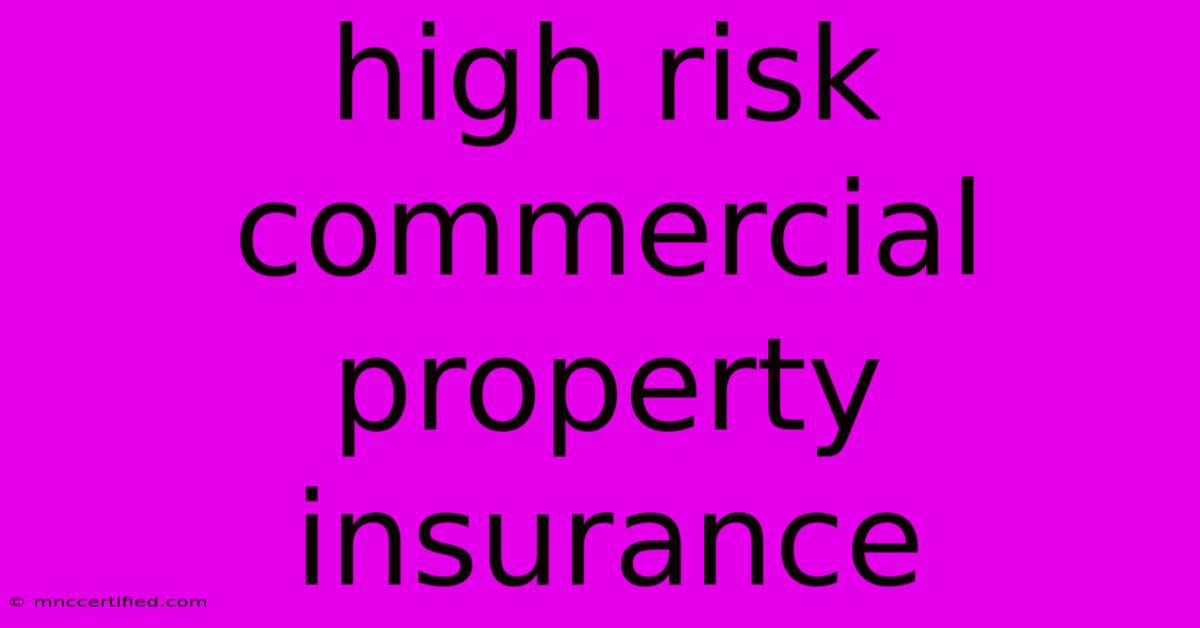High Risk Commercial Property Insurance

Table of Contents
Navigating the Risks: A Guide to High-Risk Commercial Property Insurance
Running a business involves inherent risks, and for certain industries, those risks can be significantly amplified. These high-risk commercial properties require specialized insurance coverage that goes beyond traditional policies. This guide will explore the complexities of securing insurance for high-risk businesses, the factors that influence premiums, and key strategies to mitigate risks and secure optimal coverage.
Understanding High-Risk Commercial Properties
What defines a high-risk commercial property? The answer depends on several factors, including:
- Industry: Certain industries inherently carry more risk, such as manufacturing, construction, and hospitality.
- Location: Properties in disaster-prone areas, like flood zones or earthquake-prone regions, face higher risks.
- Property Type: High-rise buildings, warehouses, and properties with unique or hazardous materials pose greater challenges for insurers.
- Operational Practices: Businesses with specific operations, like handling flammable materials or working with hazardous chemicals, require extra attention.
The Challenges of Securing Coverage
Insurers carefully assess the risks associated with high-risk properties, leading to:
- Higher Premiums: The increased potential for claims results in higher insurance costs.
- Limited Availability: Some insurers might be hesitant to offer coverage or may impose stringent conditions.
- Specialized Policies: Traditional policies might not cover the full spectrum of risks associated with high-risk businesses, requiring tailored coverage.
Key Factors Influencing Premiums
The cost of your insurance policy depends on several factors, including:
- Property Value: The higher the value of your property, the higher your premiums.
- Risk Assessment: Insurers conduct detailed assessments to determine the probability of claims, considering factors like location, industry, and operational practices.
- Claims History: Past claims, even those unrelated to the current property, can impact your premiums.
- Safety Measures: Implementing robust safety protocols and security measures can lower your premiums.
- Coverage Limits: Higher coverage limits usually come with higher premiums.
Strategies for Securing Coverage
Here's how to navigate the challenges and secure optimal insurance coverage for your high-risk commercial property:
- Partner with Specialized Brokers: These brokers have expertise in high-risk commercial insurance and can help you navigate the complexities of the market.
- Focus on Risk Mitigation: Implement comprehensive safety measures and security protocols to minimize potential risks.
- Maintain Detailed Records: Accurate records of property value, safety protocols, and claims history can help demonstrate your business's responsible approach.
- Shop Around for Quotes: Compare quotes from multiple insurers to find the best fit for your needs and budget.
- Negotiate Coverage: Don't hesitate to negotiate terms and coverage limits to tailor the policy to your specific requirements.
Key Coverages for High-Risk Properties
High-risk commercial properties often require additional coverages beyond standard policies, including:
- Business Income Coverage: Provides financial protection against lost income due to covered perils.
- Extra Expense Coverage: Reimburses additional expenses incurred to continue operations during a covered event.
- Liability Coverage: Protects against claims from third parties for injuries or damages.
- Pollution Liability Coverage: Offers protection against environmental pollution risks.
- Equipment Breakdown Coverage: Provides coverage for unexpected breakdowns or failures of essential equipment.
Protecting Your Business: Investing in Security
Beyond securing insurance, investing in comprehensive security measures is crucial:
- Fire Safety Systems: Install and maintain modern fire detection and suppression systems.
- Security Systems: Implement robust security measures, including alarms, surveillance cameras, and access control systems.
- Employee Training: Provide regular training to employees on safety protocols and emergency procedures.
- Regular Maintenance: Conduct regular inspections and maintenance of property and equipment to minimize potential hazards.
Conclusion
Navigating the complexities of high-risk commercial property insurance can be challenging. However, by understanding the risks, partnering with specialized brokers, and investing in comprehensive security measures, you can secure the necessary coverage to protect your business. Remember that insurance is an investment in your future, ensuring that your business can recover from unexpected events and continue thriving.

Thank you for visiting our website wich cover about High Risk Commercial Property Insurance. We hope the information provided has been useful to you. Feel free to contact us if you have any questions or need further assistance. See you next time and dont miss to bookmark.
Featured Posts
-
Dental Bonding Before And After Photos
Nov 09, 2024
-
Florida Farmer Alfie Oakes Seed To Table Story
Nov 09, 2024
-
How Much Is An Ent Visit With Insurance
Nov 09, 2024
-
76ers Vs Lakers Odds Expert Analysis
Nov 09, 2024
-
La Liga Live Streaming Us Guide For Nov 8th
Nov 09, 2024